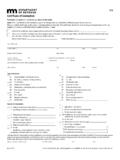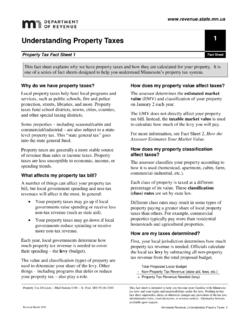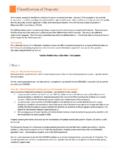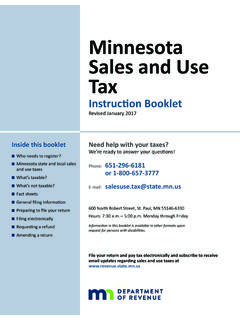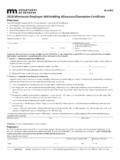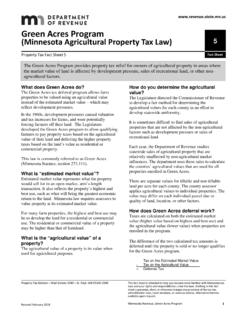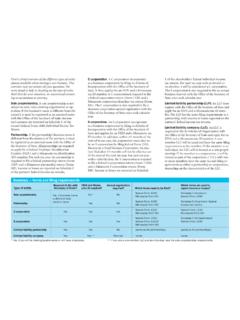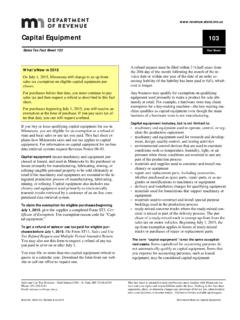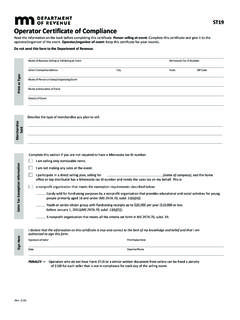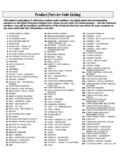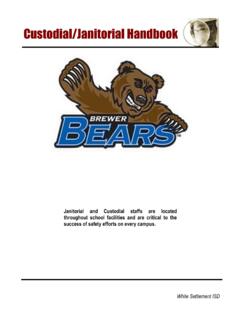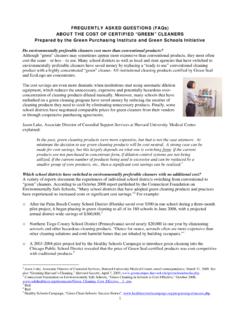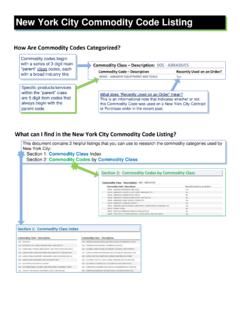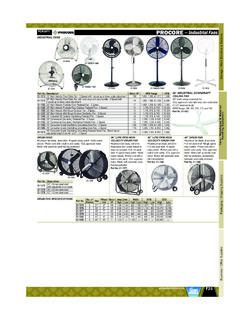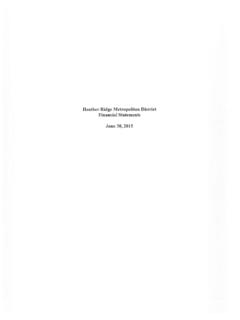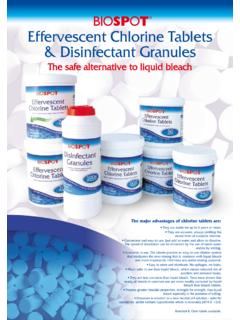Transcription of Industrial Production 145 - Minnesota Department …
1 Industrial Production 145. Sales Tax Fact Sheet 145 Fact Sheet What's New in 2017. We made the layout of this fact sheet easier to use. Starting July 1, 2015, the capital equipment refund is an up-front sales tax exemption. If you pay sales tax on purchases after June 30, 2015, you may still file a refund request for tax paid in error. This fact sheet explains how Minnesota Sales and Use Tax applies to businesses involved in Industrial Production and also how to report and pay Sales and Use Tax. Businesses must pay tax on administrative supplies, certain machinery (see Capital equipment, page 3), accessories, fur- niture, fixtures, and other items used to produce a product. However, materials used or consumed to produce a product may qualify for the Industrial Production exemption. To be eligible for this exemption, the business must produce tangible personal property intended to be sold ultimately at retail. Industrial producers include manufacturers, fabricators, miners, and refiners (see the list below for examples).
2 The Production process includes the following activities: Design, research, and development for Production of a product Removal of raw materials from stock to begin Production activities Actual Production activities that effect changes to produce the product Testing and quality control of the product Placement of the product in finished goods inventory, or if the item is not placed into inventory, the last produc- tion process before loading the product for shipment Examples of businesses engaged in Industrial Production : Bakeries Mining operations Breweries Paint factories Candy factories Paper mills Chemical processing plants Photographers Clothing manufacturers Photo copy centers Concrete plants and ready mix companies Printing companies Creameries Sawmills Electric generating plants Shoe factories Equipment manufacturers Smelting mills Film processors Soft drink bottling plants Flour and feed mills Steel mills Food processing plants Tanneries Foundries Tile producers Glass making plants Tool and die shops Machinery producers Vehicle assembly lines Sales and Use Tax Division Mail Station 6330 St.
3 Paul, MN 55146-6330 This fact sheet is intended to help you become more familiar with Minnesota tax Phone: 651-296-6181 or 1-800-657-3777 laws and your rights and responsibilities under the laws. Nothing in this fact sheet Email: supersedes, alters, or otherwise changes any provisions of the tax law, administrative rules, court decisions, or revenue notices. Alternative formats available upon request. Stock No. 2800145, Revised December 2017 Minnesota Revenue, Industrial Production Examples of businesses not engaged in Industrial Production : Agricultural operations Mobile phone services Accounting firms Movie theaters Banks Restaurants Car and truck washes Repair shops Contractors Service stations Dry cleaners Retail stores Hotels and motels Telephone companies Pipeline transmission companies Trucking operations Laundries Vending machine operators Law firms Exempt purchases To buy items exempt from tax, the purchaser must give a completed Form ST3, Certificate of Exemption, to the seller.
4 The following are examples of exempt purchases: Chemicals, materials, and supplies used in Materials that directly affect the product, such treating waste (including water) generated as a as grinding and polishing compounds, and result of a Production process sanding disks Chemicals used or consumed in Production , in- Materials used for the original painting and cluding chemicals used for cleaning food pro- cleaning of products cessing equipment Materials used one time in Production , not con- Component parts and ingredients of a product sumed, but discarded after one use, such as key Crucibles, thermocouple protection sheaths and lines, typesetting, paper pans and cake liners, tubes, stalk tubes, refractory materials, molten disposable dishes, swabs, and lab testing solu- metal filters, and filter boxes, degassing lances, tions and base blocks used in metal casting Petroleum products and lubricants used in pro- Fuels electricity, natural gas, water, steam, pro- duction equipment, such as oil, grease, radiator pane gas, and gas used directly in the pro- antifreeze, penetrating oil.
5 Pulsar oil, and surge duction process. For more information, see Fact oil Sheet 129, Utilities Used in Production . Product identification labels, including combi- Industrial gases used in Production (oxygen, nation labels that identify the product and price acetylene, argon) Product packaging materials Separate detachable tools (see below for quali- fications). Form ST3, Certificate of Exemption To buy items exempt from tax, you must give the vendor a completed Form ST3, Certificate of Exemption. The reason for the exemption is Industrial Production to buy items that are consumed in the Production process or that are ingredi- ents or components of the final product. Use Percentage exemption to exempt a percentage of fuels or energy, based upon consumption during the Production process. Use Resale exemption when the item purchased will be resold in its original form. Special tooling Special tooling is exempt. Special tooling means tools, dies, jigs, patterns, gauges, and other special tools that have value and use only for the buyer and use for which they are made.
6 A tool may be purchased exempt if all of the following con- ditions are met: 1. It is not standard enough to be stocked or ordered from a catalog or other sales literature 2. It must be produced in accordance with special requirements peculiar to the buyer 3. It is not commonly usable by someone else whose conditions for possible use of the material are reasonably sim- ilar Minnesota Revenue, Direct Sales Companies 2. Materials purchased to make your own special tooling are taxable, because materials are not special tools as described above. Some accessory tools, dies, molds, and other short-lived items that don't qualify as special tooling may qualify for the separate detachable unit exemption. Separate detachable units Accessory tools, dies, molds, and other short-lived items are exempt if all three of the following requirements are met: 1. It must be an accessory tool, equipment, or short-lived item that attaches to a machine while in use.
7 It must be pur- chased separately from the basic machine, or their cost must be separately stated. 2. It must be used in producing a direct effect on the product. Direct affect causes physical or chemical change on or within materials being processed, or determines shape, contour, configuration, content, or arrangement of the product. 3. Its ordinary useful life is less than 12 months when used continuously in Production under normal conditions of the user. Junking, scrapping, or wearing out is conclusive evidence of the end of a tool's useful life. Retention and re-use are evidence of continued useful life. Materials to make your own qualifying detachable tools may be purchased exempt. Separate detachable units do not include the basic machine or any components included in the original purchase price. Examples of separate detachable units that may qualify for exemption include: Abrasive and polishing belts Molds Barrels and screws for extruder machines Patterns Cutting tools Polishing felt strips and buffers Dies Printing plates Drill bits Reamers Grind wheels (used to affect product) Sanding sheets and discs Hand tool attachments Saw blades Jigs Stone sawing wires Materials to make qualifying detachable tool Other items used in cutting or welding processes that do not physically come in contact with the product but have a di- rect effect on it, may qualify for exemption.
8 Examples include: Contact tips Nozzles Copper outer cups Plastic inner cups Cutting tips Shield cups Electrodes Spray nozzles Gas diffuser items Examples of items that are not separate detachable units (but may qualify for the capital equipment exemption): Arbors Grinding wheels (used to sharpen tools). Batteries Power hand tools Bearings Pulleys Collets Seals Conveyor belts Shafts Drill chucks Soldering irons Gears Capital equipment Capital equipment means machinery and equipment purchased or leased, and used in Minnesota by the purchaser or les- see primarily for manufacturing, fabricating, mining, or refining tangible personal property to be sold ultimately at retail 3 Minnesota Revenue, Industrial Production if the machinery and equipment are essential to the integrated Production process of manufacturing, fabricating, mining, or refining. Examples of qualifying capital equipment include: Production machinery, equipment, fixtures, implements Materials to make one's own Production tools Tools purchased to create tools or special tooling used in the Production process For more information, see Fact Sheet 103, Capital Equipment.
9 Beginning July 1, 2015, the capital equipment exemption is allowed at the time of purchase. To purchase exempt, the purchaser must give the seller a completed Form ST3, Certificate of Exemption. Before July 1, 2015, you must pay sales or use tax when you buy or lease capital equipment and apply for the refund. Packaging materials Nonreturnable materials used to package products can be purchased exempt. Returnable containers are taxable, except when used to package food and beverages. Examples of exempt packaging include: Nonreturnable internal packaging materials Product identification labels including combi- which shape, form, stabilize, and protect con- nation labels that identify the product and price tents for customers Nonreturnable pallets and skids Stuffing materials such as straw, dry ice, excel- Nonreusable external packaging materials or sior, shredded paper, foam, cotton batting, saw- dunnage which protects, braces, pads, or cush- dust, and other similar fillers ions against damage, motion, shock, or break- Warranty cards, owner manuals, content lists, age, such as cartons, containers, cans, boxes, instruction sheets, and materials safety data and bags sheets Packaging for food and beverage products, ma- Wrapping materials such as paper or plastic terials used to repair or recondition returnable wrap, wire, tape, staples, etc.
10 Food and beverage containers; and returnable packaging for food and beverage products Examples of taxable packaging: External and internal packaging materials return- Returnable skids and pallets including raw mate- able to the vendor rials purchased to construct, repair, or recondi- Labels that do not contain package content infor- tion them mation for customers, including price tags, ship- Reusable materials used for handling, storing, or ping tags, address labels, invoices, packing slips, moving materials within or between the produc- and envelopes tion facilities Returnable containers such as steel drums, bar- Warning labels that give shipping directions, rels, bottles, gas cylinders, boxes, tanks, sacks, such as do not drop or do not stack . cans (except when used to package food and beverages). Note: Deposits that are charged to customers as security for the return of containers are not taxable if separately stated on the invoice.
